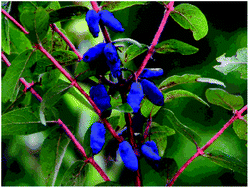Effects of oral administration of Lonicera caerulea berries on UVB-induced damage in SKH-1 mice. A pilot study
Abstract
Solar ultraviolet radiation is a major environmental factor that has serious adverse effects on the structure and function of the skin. Although the UVB waveband (295–315 nm) represents only 5–10% of incoming UV light, it is very damaging to the skin. The aim of this study was to investigate the effect of Lonicera caerulea berries on UVB-induced damage to SKH-1 hairless mice. Mice were fed a L. caerulea berry-enriched diet (10%, w/w) for 14 days before a single UVB (1000 mJ cm−2) treatment. Effects on health status, antioxidant enzyme activity and expression, and DNA damage were evaluated. The bioavailability of L. caerulea phenolic components was also assessed. We found that feeding with L. caerulea berries prevented a decrease in catalase activity and stimulated NADPH quinone oxidoreductase-1, heme oxygenase-1, and gamma-glutamylcysteine synthetase catalytic and modulatory subunit expression in UVB exposed mice. Administration of the L. caerulea berry-enriched diet led to an increase in UVB-reduced interleukin-17 levels and a decrease in keratinocyte-derived chemokine protein expression that was enhanced after UVB treatment. Further, L. caerulea berries reduced UVB-induced DNA damage evaluated as number of single strand breaks, cyclobutane–pyrimidine dimer formation and H2AX phosphorylation, a marker of double strand breaks. Taken together, we provide evidence that oral administration of L. caerulea berries to mice affords at least partial protection from the adverse effects of a single UVB exposure via modulation of antioxidant enzyme activity/expression and reduction of DNA damage.


 Please wait while we load your content...
Please wait while we load your content...